Mindanao State University ENG103: Deep Dive into English Phonetics
VerifiedAdded on 2023/07/11
|27
|5732
|268
Homework Assignment
AI Summary
This assignment solution for ENG103, English Phonology and Morphology, focuses on phonetics, covering its definition, the three main branches (articulatory, acoustic, and auditory phonetics), and their significance in language learning. It includes activities such as watching videos and answering questions to understand phonetics better. The solution also covers the production of consonant sounds, detailing voicing, place of articulation, and manner of articulation, along with explanations of voiced and voiceless sounds, and Voice Onset Time (VOT). Furthermore, it discusses vowels, including monophthongs and diphthongs, and states of the glottis, such as creaky voice. The material is designed to help students at Mindanao State University grasp the fundamental concepts of phonetics and morphology.
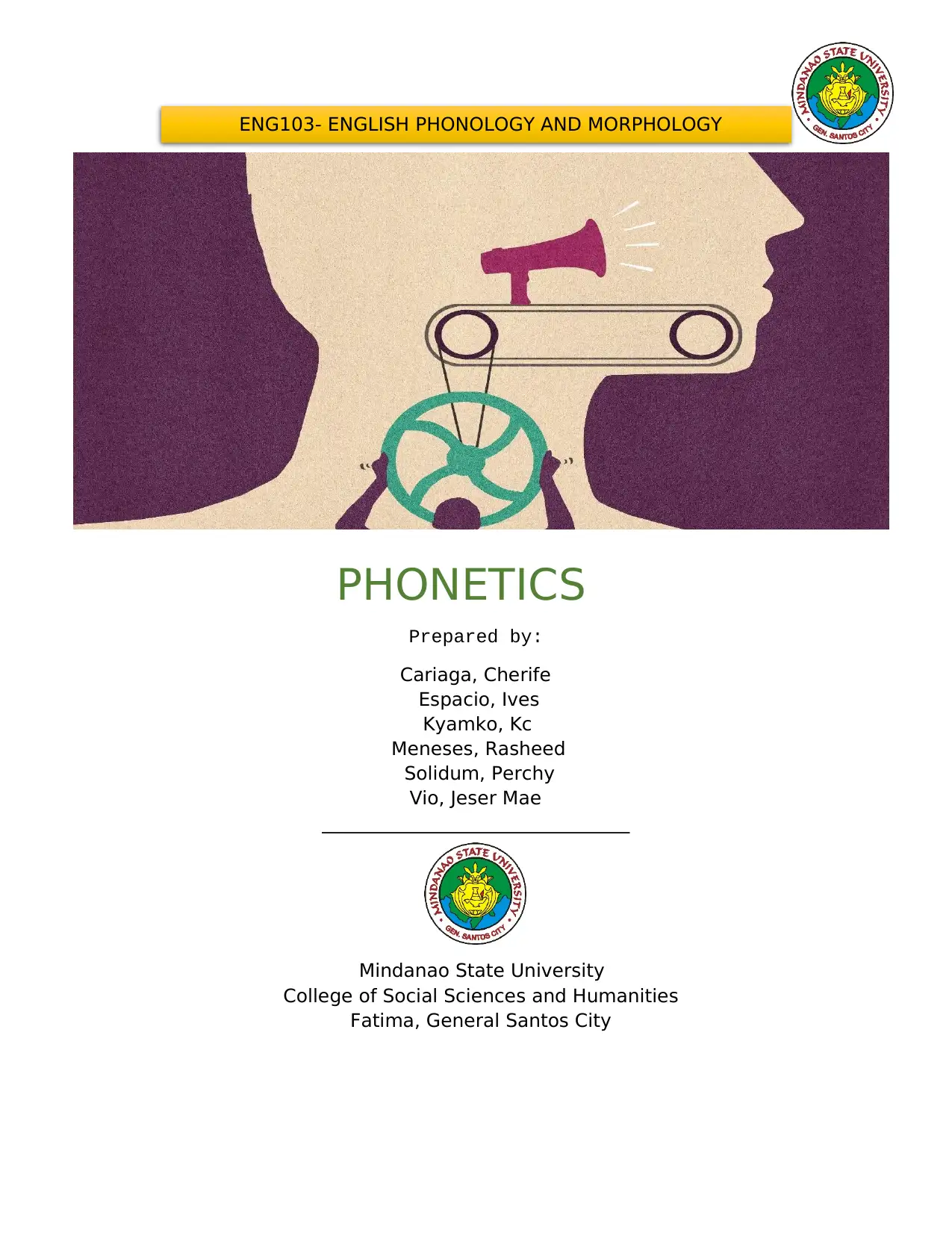
ENG103- ENGLISH PHONOLOGY AND MORPHOLOGY
PHONETICS
Prepared by:
Cariaga, Cherife
Espacio, Ives
Kyamko, Kc
Meneses, Rasheed
Solidum, Perchy
Vio, Jeser Mae
_________________________________
Mindanao State University
College of Social Sciences and Humanities
Fatima, General Santos City
PHONETICS
Prepared by:
Cariaga, Cherife
Espacio, Ives
Kyamko, Kc
Meneses, Rasheed
Solidum, Perchy
Vio, Jeser Mae
_________________________________
Mindanao State University
College of Social Sciences and Humanities
Fatima, General Santos City
Paraphrase This Document
Need a fresh take? Get an instant paraphrase of this document with our AI Paraphraser
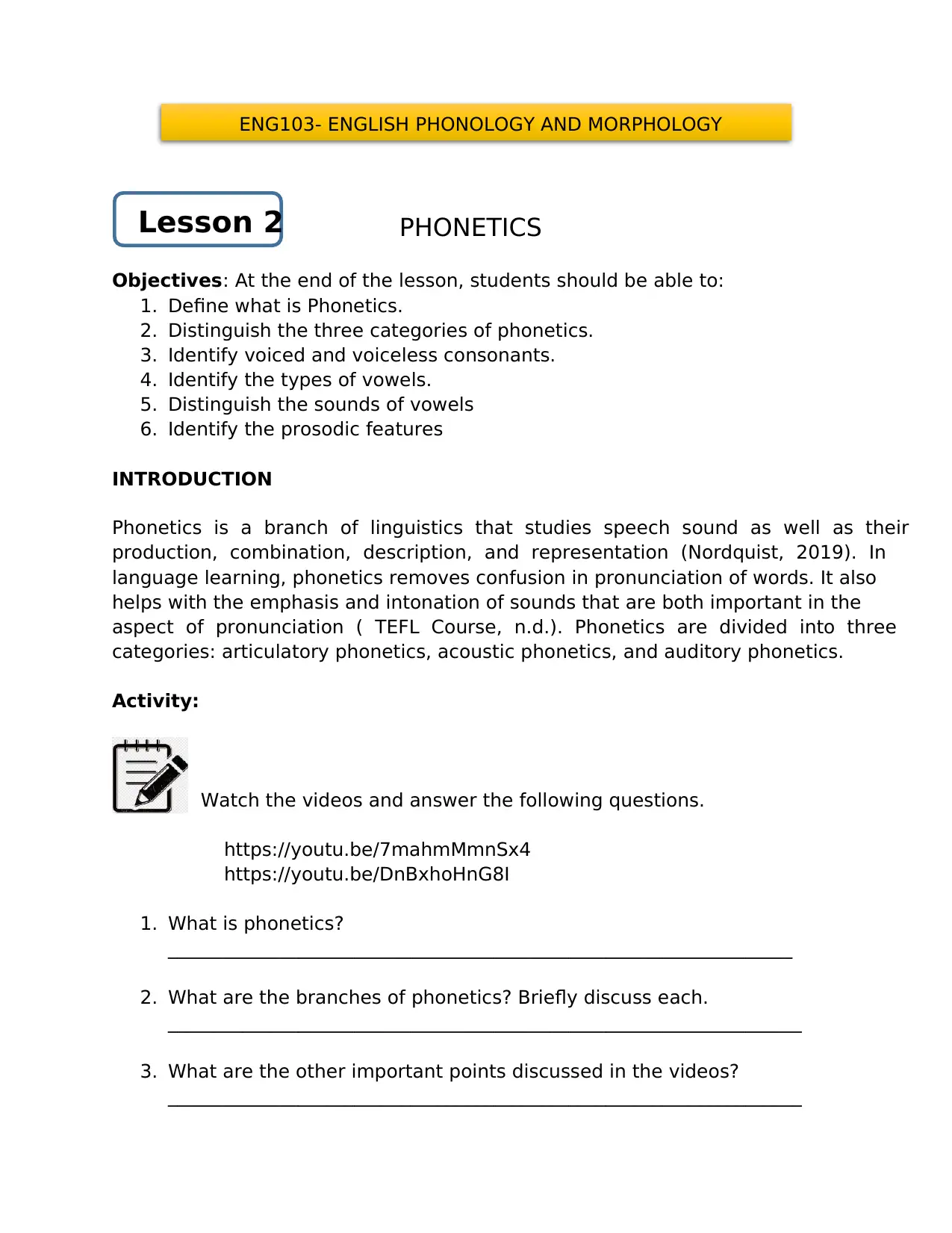
ENG103- ENGLISH PHONOLOGY AND MORPHOLOGY
PHONETICS
Objectives: At the end of the lesson, students should be able to:
1. Define what is Phonetics.
2. Distinguish the three categories of phonetics.
3. Identify voiced and voiceless consonants.
4. Identify the types of vowels.
5. Distinguish the sounds of vowels
6. Identify the prosodic features
INTRODUCTION
Phonetics is a branch of linguistics that studies speech sound as well as their
production, combination, description, and representation (Nordquist, 2019). In
language learning, phonetics removes confusion in pronunciation of words. It also
helps with the emphasis and intonation of sounds that are both important in the
aspect of pronunciation ( TEFL Course, n.d.). Phonetics are divided into three
categories: articulatory phonetics, acoustic phonetics, and auditory phonetics.
Activity:
Watch the videos and answer the following questions.
https://youtu.be/7mahmMmnSx4
https://youtu.be/DnBxhoHnG8I
1. What is phonetics?
___________________________________________________________________
2. What are the branches of phonetics? Briefly discuss each.
____________________________________________________________________
3. What are the other important points discussed in the videos?
____________________________________________________________________
Lesson 2
PHONETICS
Objectives: At the end of the lesson, students should be able to:
1. Define what is Phonetics.
2. Distinguish the three categories of phonetics.
3. Identify voiced and voiceless consonants.
4. Identify the types of vowels.
5. Distinguish the sounds of vowels
6. Identify the prosodic features
INTRODUCTION
Phonetics is a branch of linguistics that studies speech sound as well as their
production, combination, description, and representation (Nordquist, 2019). In
language learning, phonetics removes confusion in pronunciation of words. It also
helps with the emphasis and intonation of sounds that are both important in the
aspect of pronunciation ( TEFL Course, n.d.). Phonetics are divided into three
categories: articulatory phonetics, acoustic phonetics, and auditory phonetics.
Activity:
Watch the videos and answer the following questions.
https://youtu.be/7mahmMmnSx4
https://youtu.be/DnBxhoHnG8I
1. What is phonetics?
___________________________________________________________________
2. What are the branches of phonetics? Briefly discuss each.
____________________________________________________________________
3. What are the other important points discussed in the videos?
____________________________________________________________________
Lesson 2
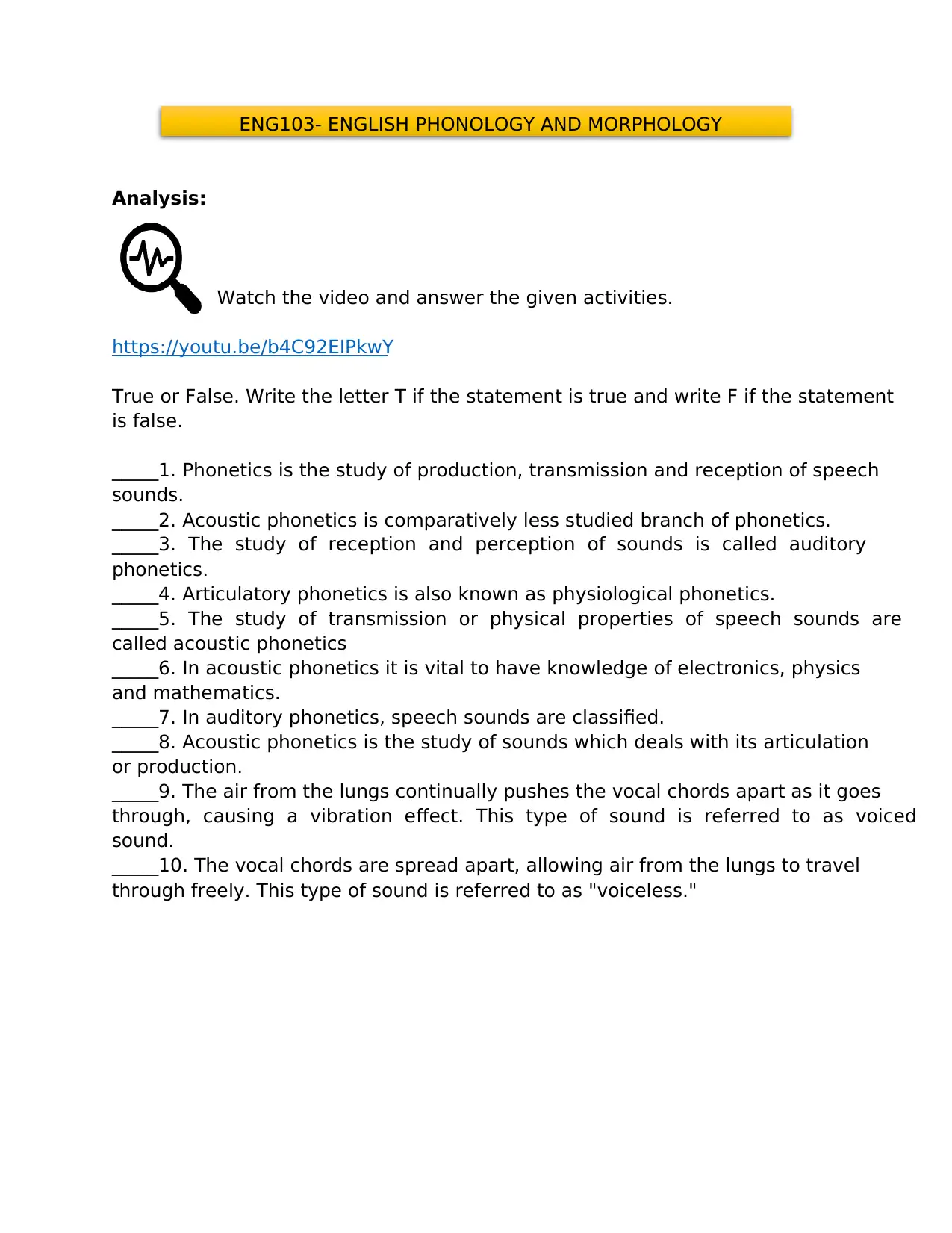
ENG103- ENGLISH PHONOLOGY AND MORPHOLOGY
Analysis:
Watch the video and answer the given activities.
https://youtu.be/b4C92EIPkwY
True or False. Write the letter T if the statement is true and write F if the statement
is false.
_____1. Phonetics is the study of production, transmission and reception of speech
sounds.
_____2. Acoustic phonetics is comparatively less studied branch of phonetics.
_____3. The study of reception and perception of sounds is called auditory
phonetics.
_____4. Articulatory phonetics is also known as physiological phonetics.
_____5. The study of transmission or physical properties of speech sounds are
called acoustic phonetics
_____6. In acoustic phonetics it is vital to have knowledge of electronics, physics
and mathematics.
_____7. In auditory phonetics, speech sounds are classified.
_____8. Acoustic phonetics is the study of sounds which deals with its articulation
or production.
_____9. The air from the lungs continually pushes the vocal chords apart as it goes
through, causing a vibration effect. This type of sound is referred to as voiced
sound.
_____10. The vocal chords are spread apart, allowing air from the lungs to travel
through freely. This type of sound is referred to as "voiceless."
Analysis:
Watch the video and answer the given activities.
https://youtu.be/b4C92EIPkwY
True or False. Write the letter T if the statement is true and write F if the statement
is false.
_____1. Phonetics is the study of production, transmission and reception of speech
sounds.
_____2. Acoustic phonetics is comparatively less studied branch of phonetics.
_____3. The study of reception and perception of sounds is called auditory
phonetics.
_____4. Articulatory phonetics is also known as physiological phonetics.
_____5. The study of transmission or physical properties of speech sounds are
called acoustic phonetics
_____6. In acoustic phonetics it is vital to have knowledge of electronics, physics
and mathematics.
_____7. In auditory phonetics, speech sounds are classified.
_____8. Acoustic phonetics is the study of sounds which deals with its articulation
or production.
_____9. The air from the lungs continually pushes the vocal chords apart as it goes
through, causing a vibration effect. This type of sound is referred to as voiced
sound.
_____10. The vocal chords are spread apart, allowing air from the lungs to travel
through freely. This type of sound is referred to as "voiceless."
⊘ This is a preview!⊘
Do you want full access?
Subscribe today to unlock all pages.

Trusted by 1+ million students worldwide
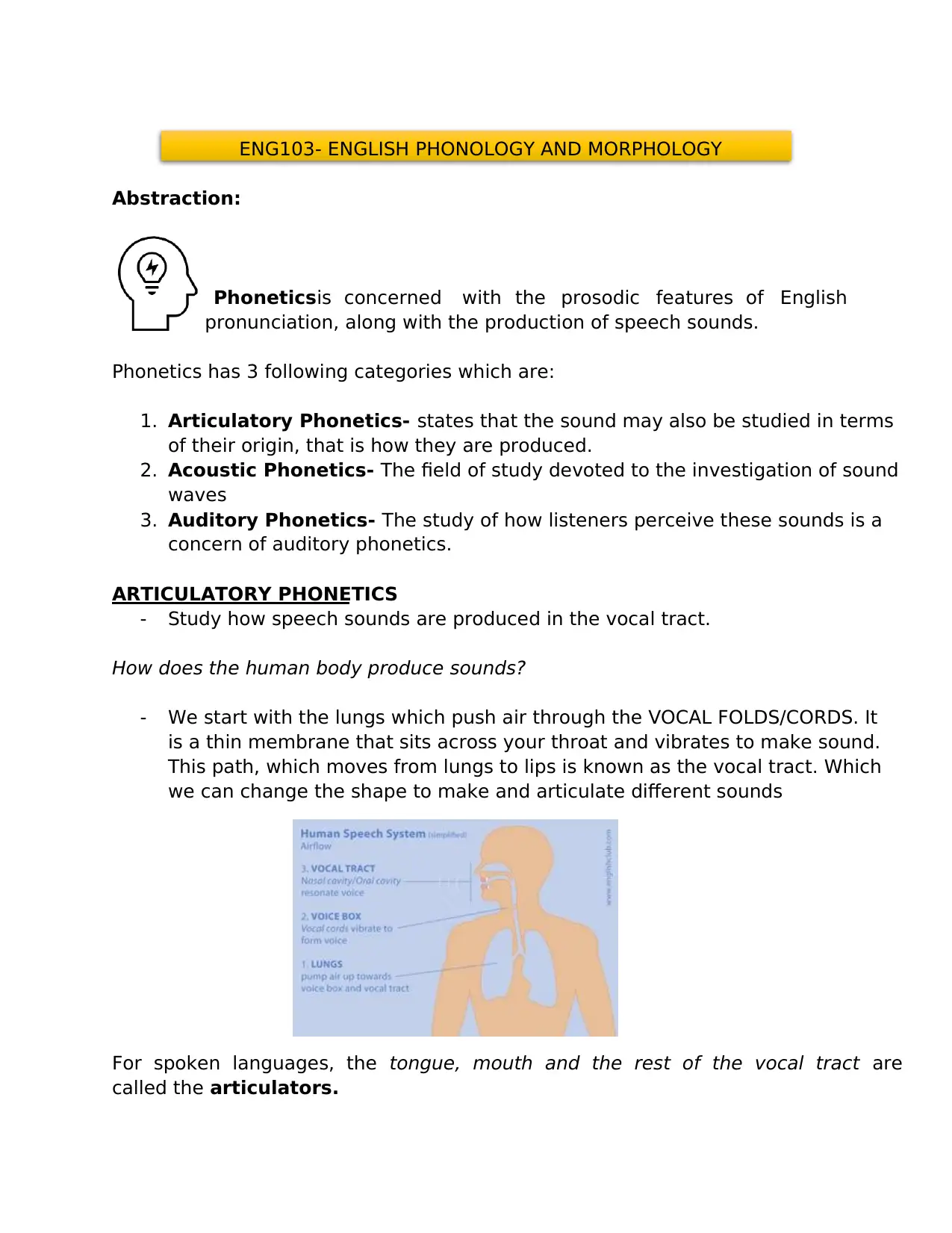
ENG103- ENGLISH PHONOLOGY AND MORPHOLOGY
Abstraction:
Phoneticsis concerned with the prosodic features of English
pronunciation, along with the production of speech sounds.
Phonetics has 3 following categories which are:
1. Articulatory Phonetics- states that the sound may also be studied in terms
of their origin, that is how they are produced.
2. Acoustic Phonetics- The field of study devoted to the investigation of sound
waves
3. Auditory Phonetics- The study of how listeners perceive these sounds is a
concern of auditory phonetics.
ARTICULATORY PHONETICS
- Study how speech sounds are produced in the vocal tract.
How does the human body produce sounds?
- We start with the lungs which push air through the VOCAL FOLDS/CORDS. It
is a thin membrane that sits across your throat and vibrates to make sound.
This path, which moves from lungs to lips is known as the vocal tract. Which
we can change the shape to make and articulate different sounds
For spoken languages, the tongue, mouth and the rest of the vocal tract are
called the articulators.
Abstraction:
Phoneticsis concerned with the prosodic features of English
pronunciation, along with the production of speech sounds.
Phonetics has 3 following categories which are:
1. Articulatory Phonetics- states that the sound may also be studied in terms
of their origin, that is how they are produced.
2. Acoustic Phonetics- The field of study devoted to the investigation of sound
waves
3. Auditory Phonetics- The study of how listeners perceive these sounds is a
concern of auditory phonetics.
ARTICULATORY PHONETICS
- Study how speech sounds are produced in the vocal tract.
How does the human body produce sounds?
- We start with the lungs which push air through the VOCAL FOLDS/CORDS. It
is a thin membrane that sits across your throat and vibrates to make sound.
This path, which moves from lungs to lips is known as the vocal tract. Which
we can change the shape to make and articulate different sounds
For spoken languages, the tongue, mouth and the rest of the vocal tract are
called the articulators.
Paraphrase This Document
Need a fresh take? Get an instant paraphrase of this document with our AI Paraphraser
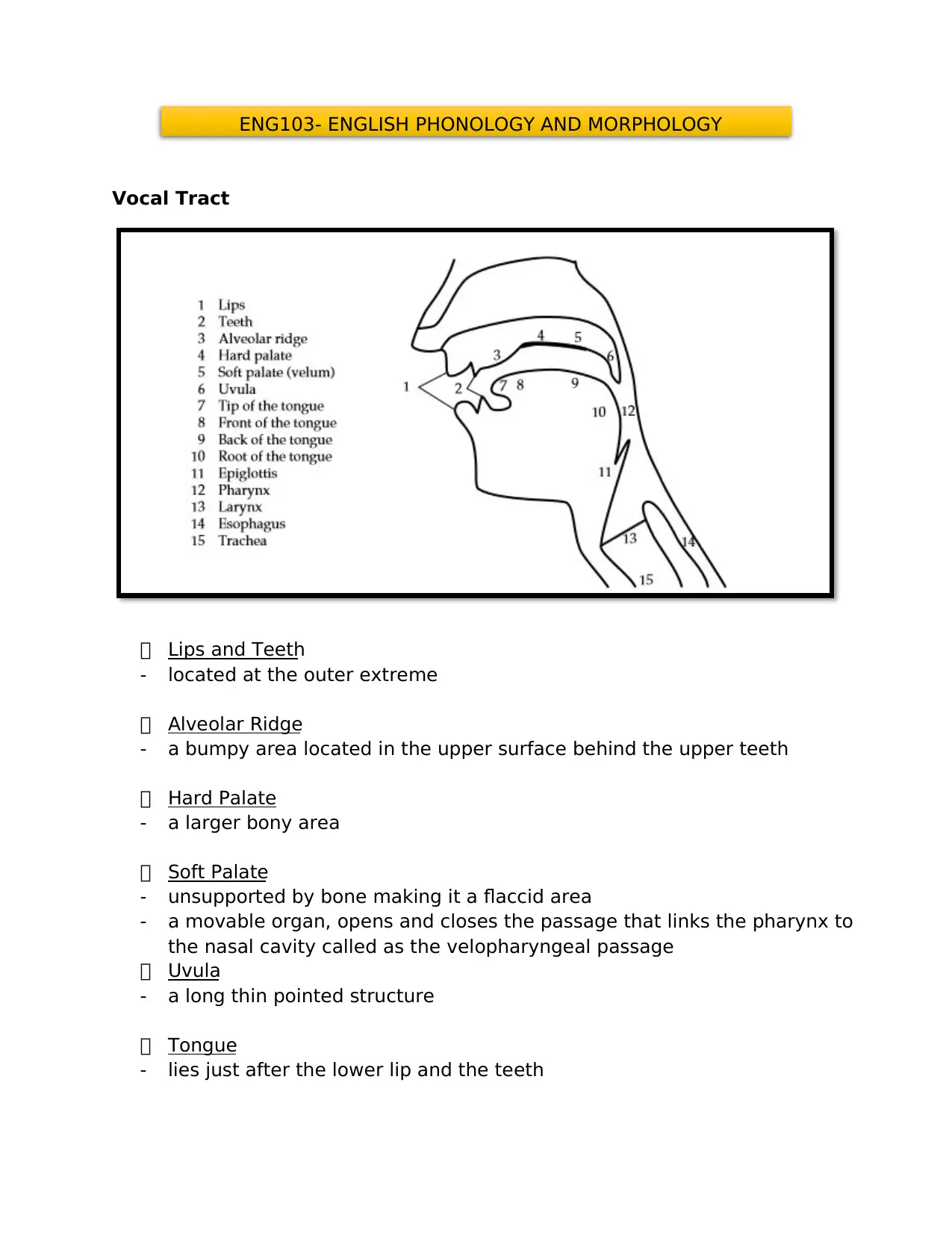
ENG103- ENGLISH PHONOLOGY AND MORPHOLOGY
Vocal Tract
Lips and Teeth
- located at the outer extreme
Alveolar Ridge
- a bumpy area located in the upper surface behind the upper teeth
Hard Palate
- a larger bony area
Soft Palate
- unsupported by bone making it a flaccid area
- a movable organ, opens and closes the passage that links the pharynx to
the nasal cavity called as the velopharyngeal passage
Uvula
- a long thin pointed structure
Tongue
- lies just after the lower lip and the teeth
Vocal Tract
Lips and Teeth
- located at the outer extreme
Alveolar Ridge
- a bumpy area located in the upper surface behind the upper teeth
Hard Palate
- a larger bony area
Soft Palate
- unsupported by bone making it a flaccid area
- a movable organ, opens and closes the passage that links the pharynx to
the nasal cavity called as the velopharyngeal passage
Uvula
- a long thin pointed structure
Tongue
- lies just after the lower lip and the teeth
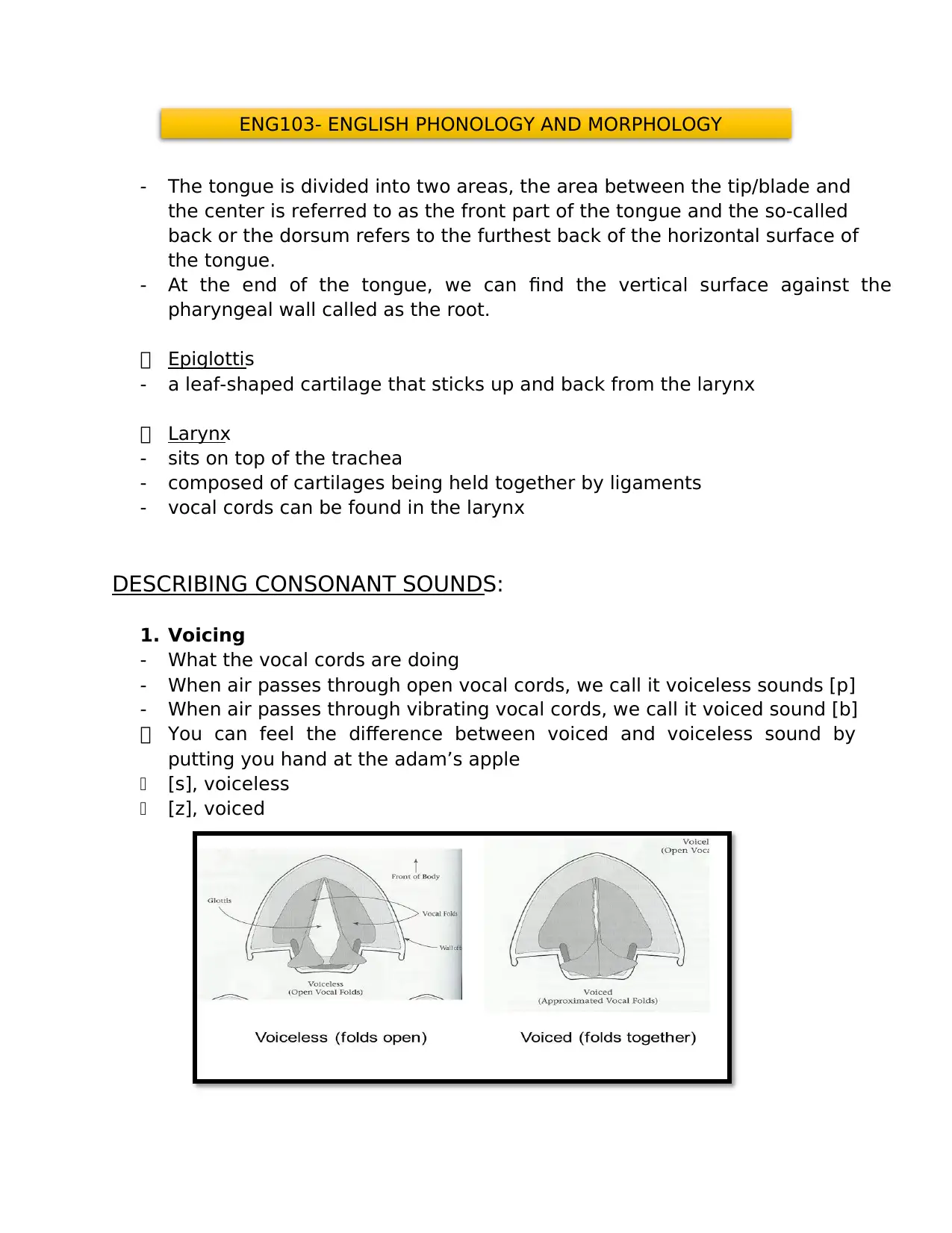
ENG103- ENGLISH PHONOLOGY AND MORPHOLOGY
- The tongue is divided into two areas, the area between the tip/blade and
the center is referred to as the front part of the tongue and the so-called
back or the dorsum refers to the furthest back of the horizontal surface of
the tongue.
- At the end of the tongue, we can find the vertical surface against the
pharyngeal wall called as the root.
Epiglottis
- a leaf-shaped cartilage that sticks up and back from the larynx
Larynx
- sits on top of the trachea
- composed of cartilages being held together by ligaments
- vocal cords can be found in the larynx
DESCRIBING CONSONANT SOUNDS:
1. Voicing
- What the vocal cords are doing
- When air passes through open vocal cords, we call it voiceless sounds [p]
- When air passes through vibrating vocal cords, we call it voiced sound [b]
You can feel the difference between voiced and voiceless sound by
putting you hand at the adam’s apple
[s], voiceless
[z], voiced
- The tongue is divided into two areas, the area between the tip/blade and
the center is referred to as the front part of the tongue and the so-called
back or the dorsum refers to the furthest back of the horizontal surface of
the tongue.
- At the end of the tongue, we can find the vertical surface against the
pharyngeal wall called as the root.
Epiglottis
- a leaf-shaped cartilage that sticks up and back from the larynx
Larynx
- sits on top of the trachea
- composed of cartilages being held together by ligaments
- vocal cords can be found in the larynx
DESCRIBING CONSONANT SOUNDS:
1. Voicing
- What the vocal cords are doing
- When air passes through open vocal cords, we call it voiceless sounds [p]
- When air passes through vibrating vocal cords, we call it voiced sound [b]
You can feel the difference between voiced and voiceless sound by
putting you hand at the adam’s apple
[s], voiceless
[z], voiced
⊘ This is a preview!⊘
Do you want full access?
Subscribe today to unlock all pages.

Trusted by 1+ million students worldwide
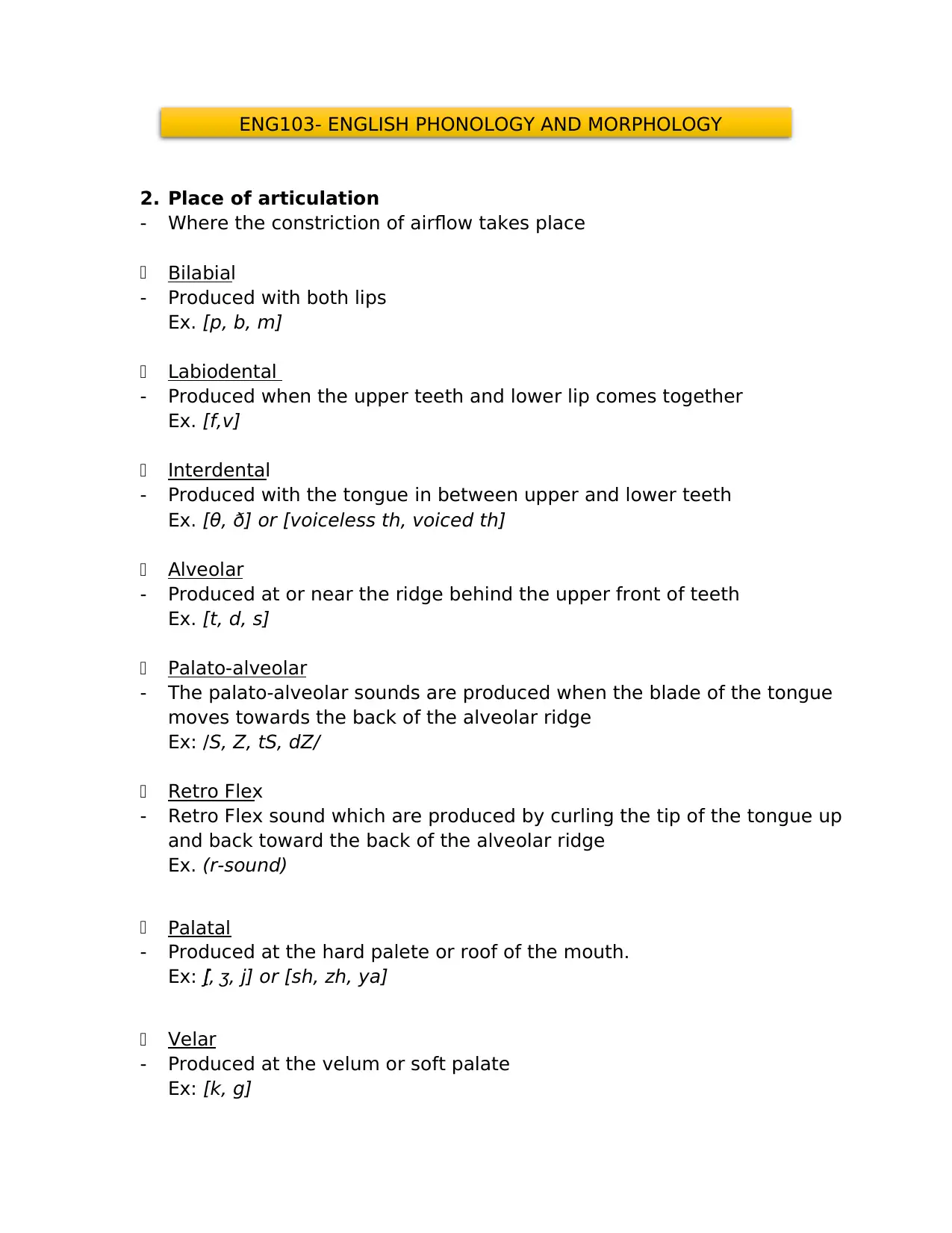
ENG103- ENGLISH PHONOLOGY AND MORPHOLOGY
2. Place of articulation
- Where the constriction of airflow takes place
Bilabial
- Produced with both lips
Ex. [p, b, m]
Labiodental
- Produced when the upper teeth and lower lip comes together
Ex. [f,v]
Interdental
- Produced with the tongue in between upper and lower teeth
Ex. [θ, ð] or [voiceless th, voiced th]
Alveolar
- Produced at or near the ridge behind the upper front of teeth
Ex. [t, d, s]
Palato-alveolar
- The palato-alveolar sounds are produced when the blade of the tongue
moves towards the back of the alveolar ridge
Ex: /S, Z, tS, dZ/
Retro Flex
- Retro Flex sound which are produced by curling the tip of the tongue up
and back toward the back of the alveolar ridge
Ex. (r-sound)
Palatal
- Produced at the hard palete or roof of the mouth.
Ex: [ʃ, ʒ, j] or [sh, zh, ya]
Velar
- Produced at the velum or soft palate
Ex: [k, g]
2. Place of articulation
- Where the constriction of airflow takes place
Bilabial
- Produced with both lips
Ex. [p, b, m]
Labiodental
- Produced when the upper teeth and lower lip comes together
Ex. [f,v]
Interdental
- Produced with the tongue in between upper and lower teeth
Ex. [θ, ð] or [voiceless th, voiced th]
Alveolar
- Produced at or near the ridge behind the upper front of teeth
Ex. [t, d, s]
Palato-alveolar
- The palato-alveolar sounds are produced when the blade of the tongue
moves towards the back of the alveolar ridge
Ex: /S, Z, tS, dZ/
Retro Flex
- Retro Flex sound which are produced by curling the tip of the tongue up
and back toward the back of the alveolar ridge
Ex. (r-sound)
Palatal
- Produced at the hard palete or roof of the mouth.
Ex: [ʃ, ʒ, j] or [sh, zh, ya]
Velar
- Produced at the velum or soft palate
Ex: [k, g]
Paraphrase This Document
Need a fresh take? Get an instant paraphrase of this document with our AI Paraphraser
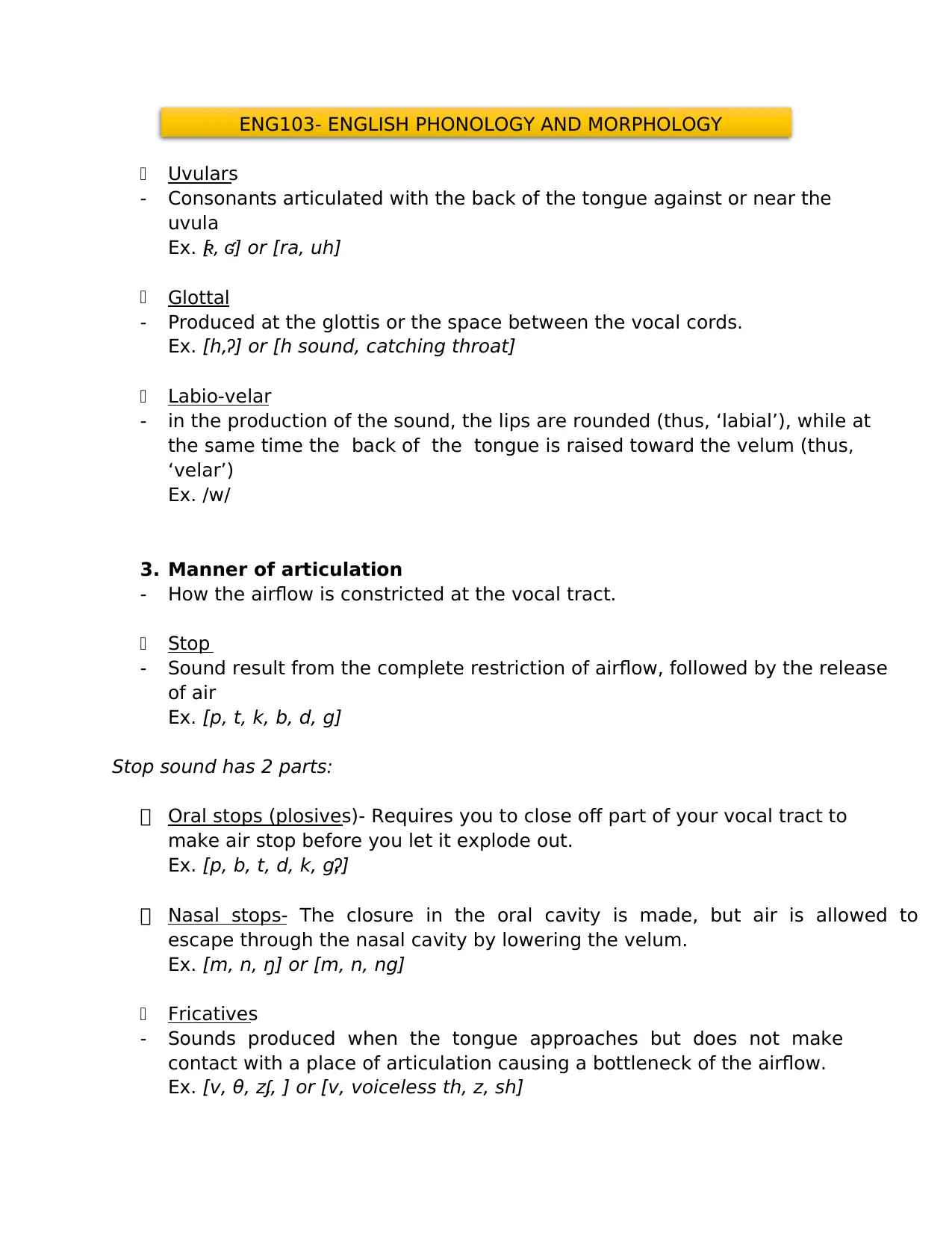
ENG103- ENGLISH PHONOLOGY AND MORPHOLOGY
Uvulars
- Consonants articulated with the back of the tongue against or near the
uvula
Ex. [ʀ, ʛ] or [ra, uh]
Glottal
- Produced at the glottis or the space between the vocal cords.
Ex. [h,ʔ] or [h sound, catching throat]
Labio-velar
- in the production of the sound, the lips are rounded (thus, ‘labial’), while at
the same time the back of the tongue is raised toward the velum (thus,
‘velar’)
Ex. /w/
3. Manner of articulation
- How the airflow is constricted at the vocal tract.
Stop
- Sound result from the complete restriction of airflow, followed by the release
of air
Ex. [p, t, k, b, d, g]
Stop sound has 2 parts:
Oral stops (plosives)- Requires you to close off part of your vocal tract to
make air stop before you let it explode out.
Ex. [p, b, t, d, k, g,ʔ]
Nasal stops- The closure in the oral cavity is made, but air is allowed to
escape through the nasal cavity by lowering the velum.
Ex. [m, n, ŋ] or [m, n, ng]
Fricatives
- Sounds produced when the tongue approaches but does not make
contact with a place of articulation causing a bottleneck of the airflow.
Ex. [v, θ, z,ʃ, ] or [v, voiceless th, z, sh]
Uvulars
- Consonants articulated with the back of the tongue against or near the
uvula
Ex. [ʀ, ʛ] or [ra, uh]
Glottal
- Produced at the glottis or the space between the vocal cords.
Ex. [h,ʔ] or [h sound, catching throat]
Labio-velar
- in the production of the sound, the lips are rounded (thus, ‘labial’), while at
the same time the back of the tongue is raised toward the velum (thus,
‘velar’)
Ex. /w/
3. Manner of articulation
- How the airflow is constricted at the vocal tract.
Stop
- Sound result from the complete restriction of airflow, followed by the release
of air
Ex. [p, t, k, b, d, g]
Stop sound has 2 parts:
Oral stops (plosives)- Requires you to close off part of your vocal tract to
make air stop before you let it explode out.
Ex. [p, b, t, d, k, g,ʔ]
Nasal stops- The closure in the oral cavity is made, but air is allowed to
escape through the nasal cavity by lowering the velum.
Ex. [m, n, ŋ] or [m, n, ng]
Fricatives
- Sounds produced when the tongue approaches but does not make
contact with a place of articulation causing a bottleneck of the airflow.
Ex. [v, θ, z,ʃ, ] or [v, voiceless th, z, sh]
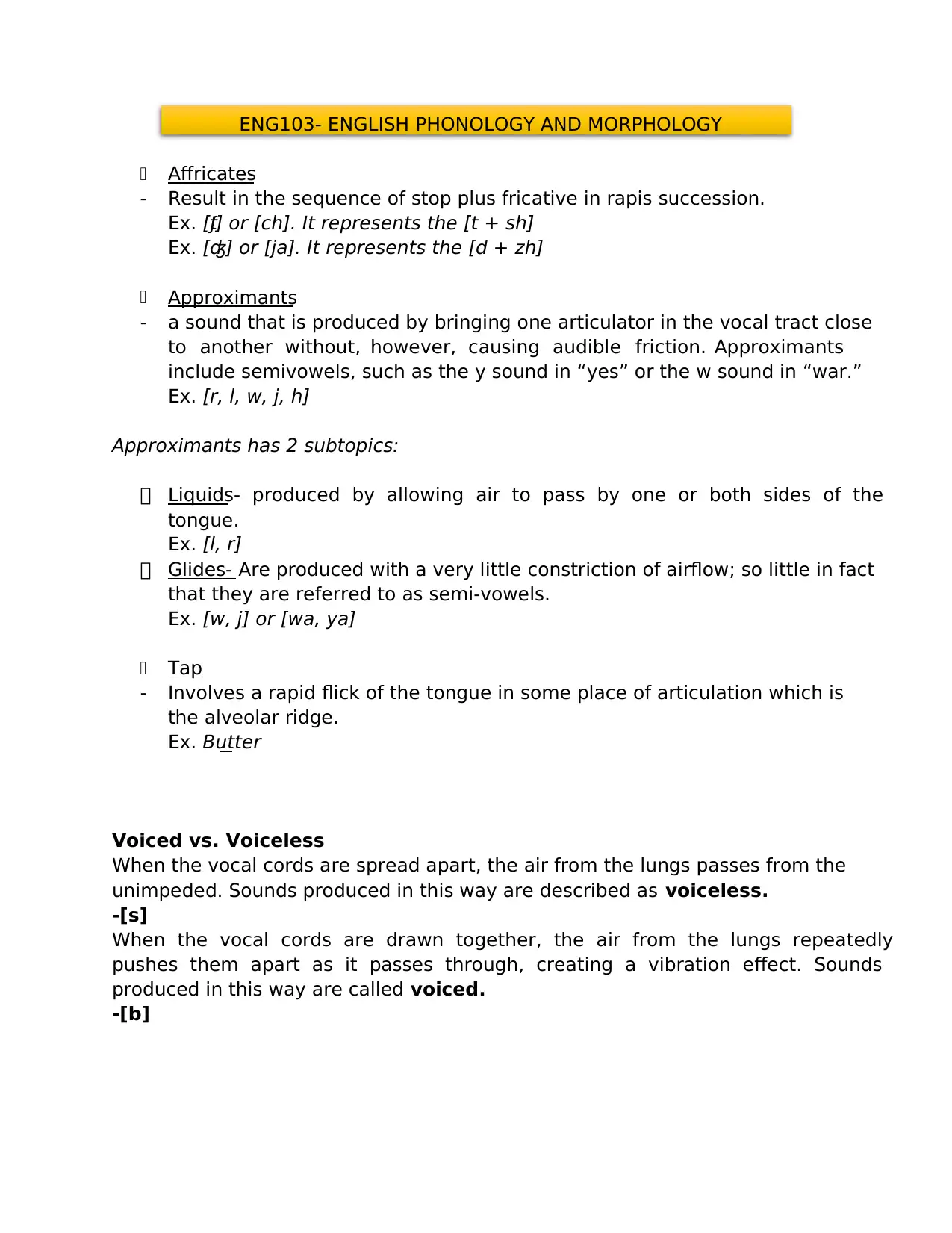
ENG103- ENGLISH PHONOLOGY AND MORPHOLOGY
Affricates
- Result in the sequence of stop plus fricative in rapis succession.
Ex. [tʃ] or [ch]. It represents the [t + sh]
Ex. [dʒ] or [ja]. It represents the [d + zh]
Approximants
- a sound that is produced by bringing one articulator in the vocal tract close
to another without, however, causing audible friction. Approximants
include semivowels, such as the y sound in “yes” or the w sound in “war.”
Ex. [r, l, w, j, h]
Approximants has 2 subtopics:
Liquids- produced by allowing air to pass by one or both sides of the
tongue.
Ex. [l, r]
Glides- Are produced with a very little constriction of airflow; so little in fact
that they are referred to as semi-vowels.
Ex. [w, j] or [wa, ya]
Tap
- Involves a rapid flick of the tongue in some place of articulation which is
the alveolar ridge.
Ex. Butter
Voiced vs. Voiceless
When the vocal cords are spread apart, the air from the lungs passes from the
unimpeded. Sounds produced in this way are described as voiceless.
-[s]
When the vocal cords are drawn together, the air from the lungs repeatedly
pushes them apart as it passes through, creating a vibration effect. Sounds
produced in this way are called voiced.
-[b]
Affricates
- Result in the sequence of stop plus fricative in rapis succession.
Ex. [tʃ] or [ch]. It represents the [t + sh]
Ex. [dʒ] or [ja]. It represents the [d + zh]
Approximants
- a sound that is produced by bringing one articulator in the vocal tract close
to another without, however, causing audible friction. Approximants
include semivowels, such as the y sound in “yes” or the w sound in “war.”
Ex. [r, l, w, j, h]
Approximants has 2 subtopics:
Liquids- produced by allowing air to pass by one or both sides of the
tongue.
Ex. [l, r]
Glides- Are produced with a very little constriction of airflow; so little in fact
that they are referred to as semi-vowels.
Ex. [w, j] or [wa, ya]
Tap
- Involves a rapid flick of the tongue in some place of articulation which is
the alveolar ridge.
Ex. Butter
Voiced vs. Voiceless
When the vocal cords are spread apart, the air from the lungs passes from the
unimpeded. Sounds produced in this way are described as voiceless.
-[s]
When the vocal cords are drawn together, the air from the lungs repeatedly
pushes them apart as it passes through, creating a vibration effect. Sounds
produced in this way are called voiced.
-[b]
⊘ This is a preview!⊘
Do you want full access?
Subscribe today to unlock all pages.

Trusted by 1+ million students worldwide
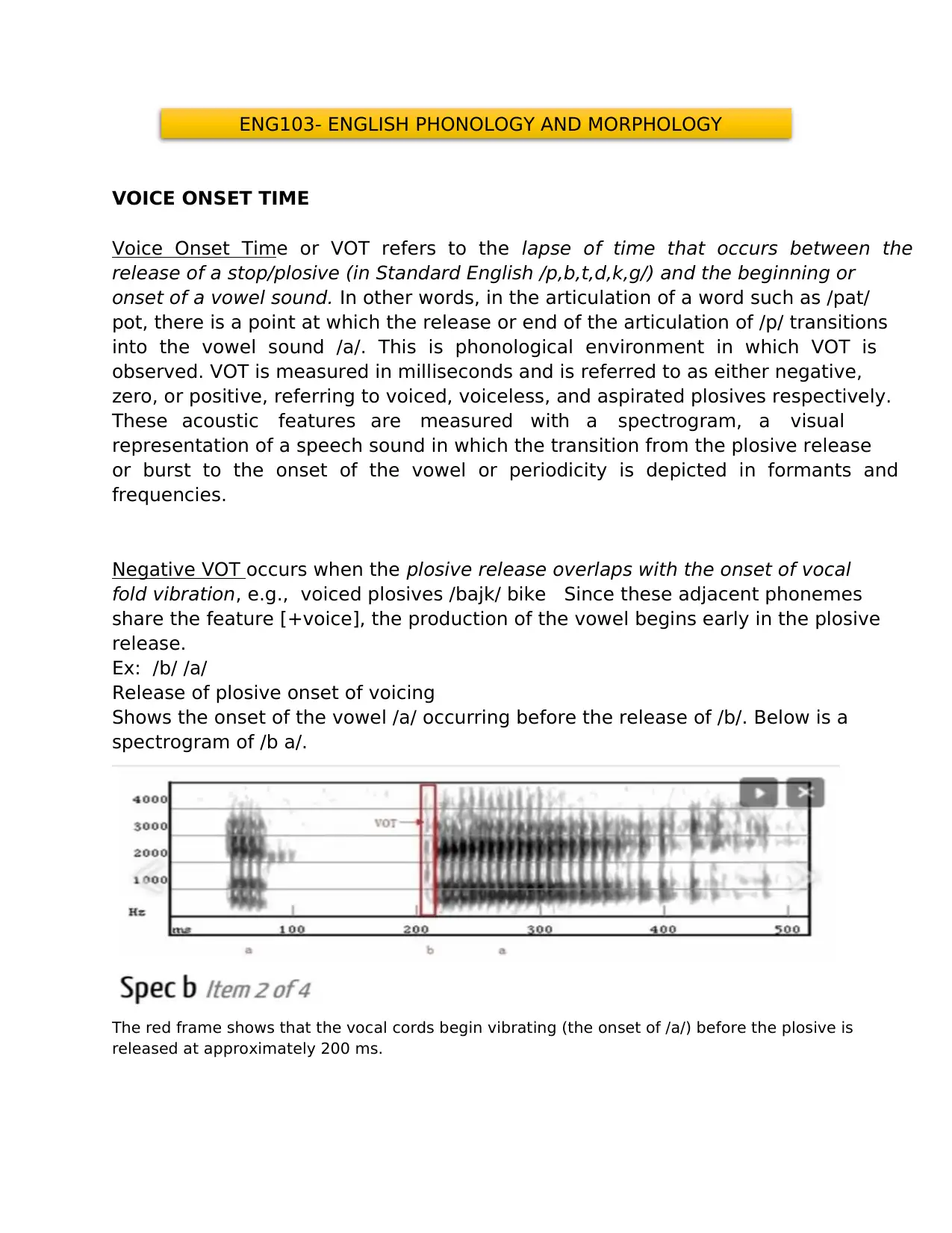
ENG103- ENGLISH PHONOLOGY AND MORPHOLOGY
VOICE ONSET TIME
Voice Onset Time or VOT refers to the lapse of time that occurs between the
release of a stop/plosive (in Standard English /p,b,t,d,k,g/) and the beginning or
onset of a vowel sound. In other words, in the articulation of a word such as /pat/
pot, there is a point at which the release or end of the articulation of /p/ transitions
into the vowel sound /a/. This is phonological environment in which VOT is
observed. VOT is measured in milliseconds and is referred to as either negative,
zero, or positive, referring to voiced, voiceless, and aspirated plosives respectively.
These acoustic features are measured with a spectrogram, a visual
representation of a speech sound in which the transition from the plosive release
or burst to the onset of the vowel or periodicity is depicted in formants and
frequencies.
Negative VOT occurs when the plosive release overlaps with the onset of vocal
fold vibration, e.g., voiced plosives /bajk/ bike Since these adjacent phonemes
share the feature [+voice], the production of the vowel begins early in the plosive
release.
Ex: /b/ /a/
Release of plosive onset of voicing
Shows the onset of the vowel /a/ occurring before the release of /b/. Below is a
spectrogram of /b a/.
The red frame shows that the vocal cords begin vibrating (the onset of /a/) before the plosive is
released at approximately 200 ms.
VOICE ONSET TIME
Voice Onset Time or VOT refers to the lapse of time that occurs between the
release of a stop/plosive (in Standard English /p,b,t,d,k,g/) and the beginning or
onset of a vowel sound. In other words, in the articulation of a word such as /pat/
pot, there is a point at which the release or end of the articulation of /p/ transitions
into the vowel sound /a/. This is phonological environment in which VOT is
observed. VOT is measured in milliseconds and is referred to as either negative,
zero, or positive, referring to voiced, voiceless, and aspirated plosives respectively.
These acoustic features are measured with a spectrogram, a visual
representation of a speech sound in which the transition from the plosive release
or burst to the onset of the vowel or periodicity is depicted in formants and
frequencies.
Negative VOT occurs when the plosive release overlaps with the onset of vocal
fold vibration, e.g., voiced plosives /bajk/ bike Since these adjacent phonemes
share the feature [+voice], the production of the vowel begins early in the plosive
release.
Ex: /b/ /a/
Release of plosive onset of voicing
Shows the onset of the vowel /a/ occurring before the release of /b/. Below is a
spectrogram of /b a/.
The red frame shows that the vocal cords begin vibrating (the onset of /a/) before the plosive is
released at approximately 200 ms.
Paraphrase This Document
Need a fresh take? Get an instant paraphrase of this document with our AI Paraphraser
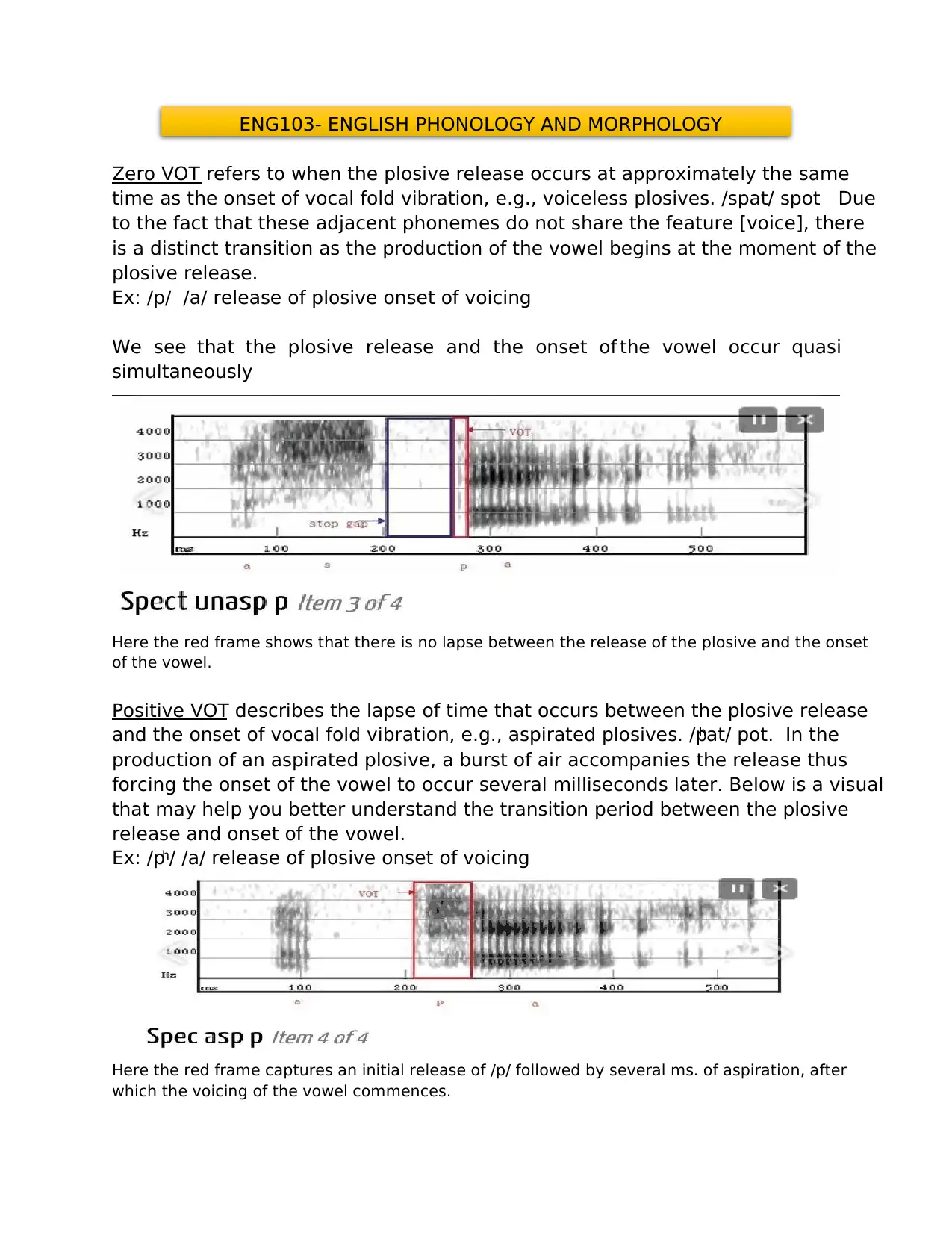
ENG103- ENGLISH PHONOLOGY AND MORPHOLOGY
Zero VOT refers to when the plosive release occurs at approximately the same
time as the onset of vocal fold vibration, e.g., voiceless plosives. /spat/ spot Due
to the fact that these adjacent phonemes do not share the feature [voice], there
is a distinct transition as the production of the vowel begins at the moment of the
plosive release.
Ex: /p/ /a/ release of plosive onset of voicing
We see that the plosive release and the onset of the vowel occur quasi
simultaneously
Here the red frame shows that there is no lapse between the release of the plosive and the onset
of the vowel.
Positive VOT describes the lapse of time that occurs between the plosive release
and the onset of vocal fold vibration, e.g., aspirated plosives. /pʰat/ pot. In the
production of an aspirated plosive, a burst of air accompanies the release thus
forcing the onset of the vowel to occur several milliseconds later. Below is a visual
that may help you better understand the transition period between the plosive
release and onset of the vowel.
Ex: /pʰ/ /a/ release of plosive onset of voicing
Here the red frame captures an initial release of /p/ followed by several ms. of aspiration, after
which the voicing of the vowel commences.
Zero VOT refers to when the plosive release occurs at approximately the same
time as the onset of vocal fold vibration, e.g., voiceless plosives. /spat/ spot Due
to the fact that these adjacent phonemes do not share the feature [voice], there
is a distinct transition as the production of the vowel begins at the moment of the
plosive release.
Ex: /p/ /a/ release of plosive onset of voicing
We see that the plosive release and the onset of the vowel occur quasi
simultaneously
Here the red frame shows that there is no lapse between the release of the plosive and the onset
of the vowel.
Positive VOT describes the lapse of time that occurs between the plosive release
and the onset of vocal fold vibration, e.g., aspirated plosives. /pʰat/ pot. In the
production of an aspirated plosive, a burst of air accompanies the release thus
forcing the onset of the vowel to occur several milliseconds later. Below is a visual
that may help you better understand the transition period between the plosive
release and onset of the vowel.
Ex: /pʰ/ /a/ release of plosive onset of voicing
Here the red frame captures an initial release of /p/ followed by several ms. of aspiration, after
which the voicing of the vowel commences.
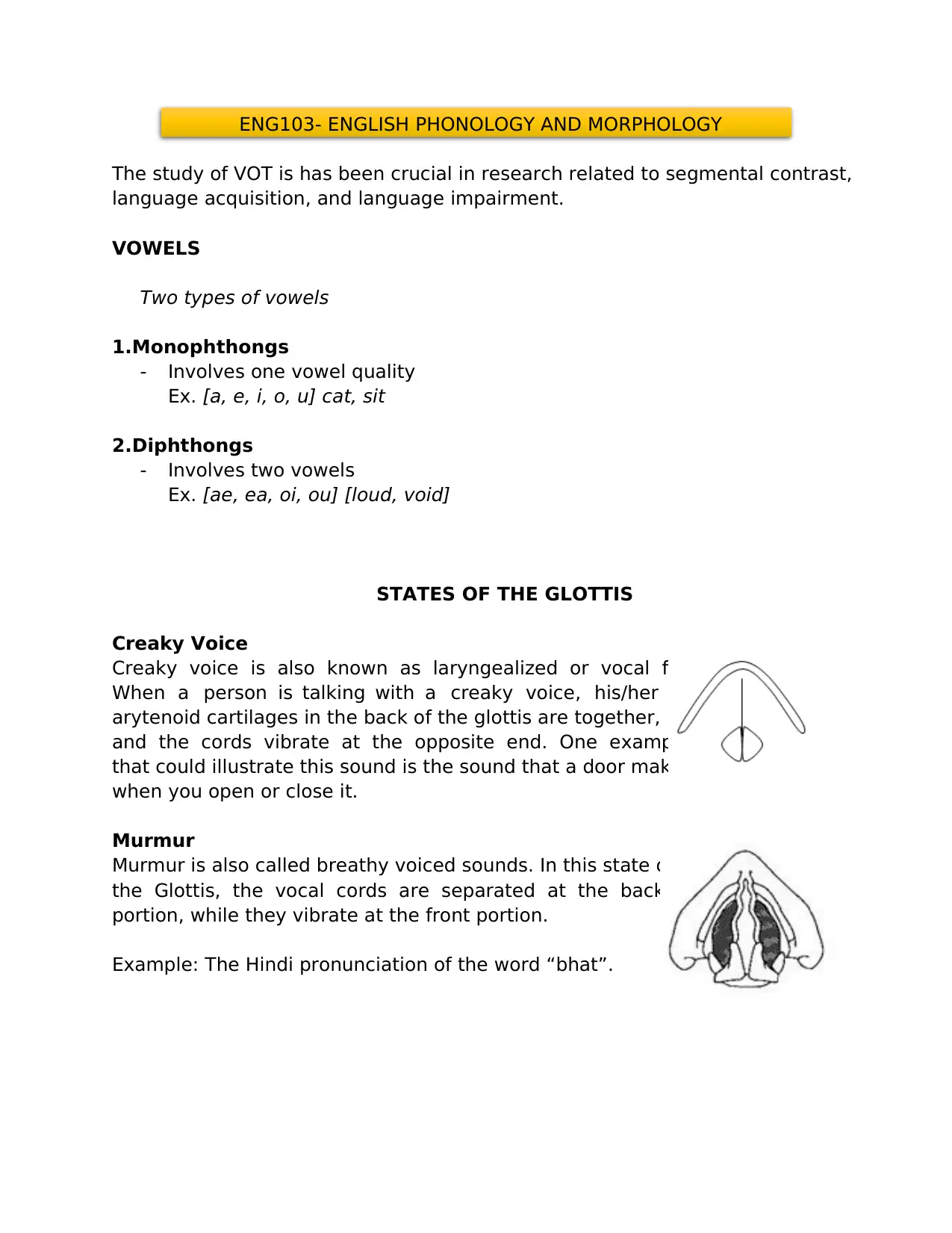
ENG103- ENGLISH PHONOLOGY AND MORPHOLOGY
The study of VOT is has been crucial in research related to segmental contrast,
language acquisition, and language impairment.
VOWELS
Two types of vowels
1.Monophthongs
- Involves one vowel quality
Ex. [a, e, i, o, u] cat, sit
2.Diphthongs
- Involves two vowels
Ex. [ae, ea, oi, ou] [loud, void]
STATES OF THE GLOTTIS
Creaky Voice
Creaky voice is also known as laryngealized or vocal fry.
When a person is talking with a creaky voice, his/her
arytenoid cartilages in the back of the glottis are together,
and the cords vibrate at the opposite end. One example
that could illustrate this sound is the sound that a door makes
when you open or close it.
Murmur
Murmur is also called breathy voiced sounds. In this state of
the Glottis, the vocal cords are separated at the back
portion, while they vibrate at the front portion.
Example: The Hindi pronunciation of the word “bhat”.
The study of VOT is has been crucial in research related to segmental contrast,
language acquisition, and language impairment.
VOWELS
Two types of vowels
1.Monophthongs
- Involves one vowel quality
Ex. [a, e, i, o, u] cat, sit
2.Diphthongs
- Involves two vowels
Ex. [ae, ea, oi, ou] [loud, void]
STATES OF THE GLOTTIS
Creaky Voice
Creaky voice is also known as laryngealized or vocal fry.
When a person is talking with a creaky voice, his/her
arytenoid cartilages in the back of the glottis are together,
and the cords vibrate at the opposite end. One example
that could illustrate this sound is the sound that a door makes
when you open or close it.
Murmur
Murmur is also called breathy voiced sounds. In this state of
the Glottis, the vocal cords are separated at the back
portion, while they vibrate at the front portion.
Example: The Hindi pronunciation of the word “bhat”.
⊘ This is a preview!⊘
Do you want full access?
Subscribe today to unlock all pages.

Trusted by 1+ million students worldwide
1 out of 27
Your All-in-One AI-Powered Toolkit for Academic Success.
+13062052269
info@desklib.com
Available 24*7 on WhatsApp / Email
![[object Object]](/_next/static/media/star-bottom.7253800d.svg)
Unlock your academic potential
Copyright © 2020–2025 A2Z Services. All Rights Reserved. Developed and managed by ZUCOL.